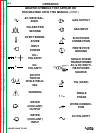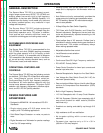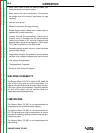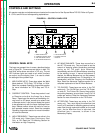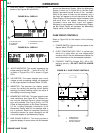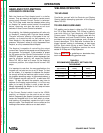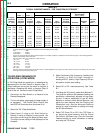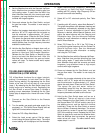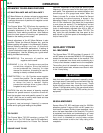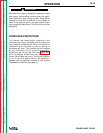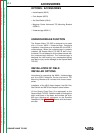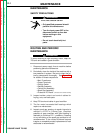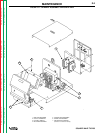
B-11
OPERATION
SQUARE WAVE TIG 255
Return to Section TOC Return to Section TOC Return to Section TOC Return to Section TOC
Return to Master TOC Return to Master TOC Return to Master TOC Return to Master TOC
Up/Down. Adjustment of the pulses per second (pulse
frequency), allows for control of the heat input into the
work piece. This adjustment can reduce distortion and
burnthrough on thin guage base metal. When the
Pulser is turned On, or when the
Pulses Per Second
are adjusted, the pulse frequency is
shown in the
Momentary Display. It can be varied from 0.5 Hz to 10
Hz in 0.5 Hz increments. (One Hertz {Hz} is equivalent
to one pulse per second.) The background current
(the welding current at the low point of the pulse
cycle) is automatically adjusted from 40% to 60% of
the peak current by the Square Wave TIG 255. The
duty cycle (the ratio between that time spent at the
peak current vs, the time spent at the background cur-
rent) is fixed at 50%.
AUXILIARY POWER
ALL MACHINES
The Square Wave TIG 255 provides 10 amps of 115
volt AC power at a standard NEMA 5-15R receptacle,
located on the lower case back of the machine. This
circuit is protected from shorts and overloading by a
10 amp circuit breaker, located next to the receptacle.
The auxiliary circuit is intended for running water cool-
ers and small power tools, whose current draw is with-
in the 10 amp rating.
Note that some types of equipment, especially pumps
and large motors, have starting currents which are sig-
nificantly higher than their running current. These
higher starting currents may cause the circuit breaker
to open. If this situation occurs, the user should refrain
from using the Square Wave TIG 255 auxiliary for that
equipment.
___________________________________________
50/60Hz MACHINES
Square Wave TIG 255 machines rated for 50/60Hz
operation provide 2 amps of 220 volt AC power at a
continental European (Schuko) type receptacle, locat-
ed on the lower case back of the machine. This circuit
is protected from shorts and overloading by a 2 amp
circuit breaker, located above the receptacle. The aux-
iliary circuit is intended for running water coolers
whose current draw is within the 2 amp rating of the
receptacle.
ADVANCED TIG WELDING FEATURES
AC WAVE BALANCE AND AUTO BALANCE™
AC Wave Balance is a feature unique to square wave
TIG power sources. It is active only in AC TIG mode.
It controls the amount of positive and negative current
in the AC output.
The Square Wave TIG 255 allows the operator to
select Auto Balance™. This selection provides
automatic adjustment of the AC Wave Balance; it is
suitable for most welding conditions. Auto Balance
gives the ideal amount of cleaning and penetration,
based on the welding current output.
Manual adjustment of the AC Wave Balance is also
possible. Select the Manual Balance key, and the
Balance setting will appear in the Momentary Display.
Manual Balance settings vary from +5 (maximum
cleaning) to -10 (maximum penetration). A setting of
0 yields a balanced output (equal amounts of cleaning
and penetration). Use the following as a guide when
setting the Balance manually:
BALANCED (0): The amounts of positive and
negative are the same.
CLEANING (+1 to +5): Provides more positive
current than negative. Since the positive
current produces the “cleaning” or oxide
removal on aluminum, this setting is used for
welding on heavily oxidized aluminum.
PENETRATION (-1 to -10): Provides more negative
current than positive. The arc plasma will be
more concentrated and more easily directed
to where the heat is needed. Higher
penetration settings allow a given size of
tungsten to carry more current.
CAUTION: Use only the amount of cleaning required
because the greater amount of positive current will
heat the tungsten more and possibly cause it to melt
or “spit”. Also, the arc is usually more flared and less
stable with more cleaning current.
In general, use just enough “cleaning” to remove
oxides and to give good wetting to the puddle.
TIG PULSER
The Square Wave TIG 255 contains a unique TIG
Pulser circuit. The TIG Pulser has On/Off selections,
as well as adjustments for Pulses Per Second
CAUTION



